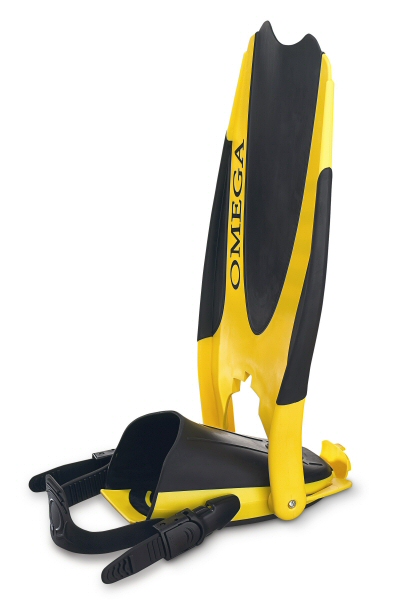Latest News
September 19, 2007
By Sara Ferris
Scuba fins are designed to propel divers swifty and smoothly through the water. On land, it’s a different story. They’re not designed for walking, and putting them on before entering the water can pose a challenge to both new and experienced divers.
Omega Aquatics (Buffalo Grove, IL), a company that focuses on developing innovative aquatic products, commissioned Designcraft (Lake Zurich, IL) to develop a fin that doesn’t hinder mobility in and out of the water—the Amphibian dynamic scuba fin, also known as a flip fin. The Amphibian fin is designed to be strapped on prior to entering the water and removed after exiting. The two-piece fins feature a hinge mechanism that comprises a molded locking structure, blade hinge assembly and anti-corrosive torsion springs.
 |
| Amphibian fins from Omega Aquatics fold up so divers can easily walk on land. |
Once in the water, the blades flip down into swimming position when the wearer kicks in the water. They flip back up when the wearer pushes back on the release levers, which can be done by hand or with the opposing heel.
The fins are also designed for high performance. “The lightweight fin blade features a soft, central web configuration modeled after a duck web,” says Omega Aquatics president and founder Ronen Moyal. “This design element contributes to increased propulsion and reduces the load required for sustained kicking.”
Moyal envisioned the need for a hinged fin years ago. “I always felt that the one thing standing in the way of a perfect dive was my fins,” said Moyal. “Walking on fins can be extremely dangerous and carrying fins in water, as most divers will tell you, can cause all kinds of problems like dropping equipment, drifting, and wasted time and energy.”
To develop and prototype his concept, Moyal turned to Designcraft, a rapid prototyping and product development company that specializes in high-quality industrial design models, engineering prototypes, high-speed CNC machining, 3D visual models, and product development.
Designcraft uses Pro/ENGINEER from PTC (Needham, MA) as its standard 3D CAD/CAM/CAE software for all product design. “Omega Aquatics brought us an innovative concept in rough 2D sketches. Pro/ENGINEER allowed us to interpret and develop the idea into a 3D solid model that could easily be modified throughout the iterative design process,” said Casey Stahl, lead designer at Designcraft.
“Initial design and development was completed in less than six months,” Stahl notes. “The initial design has evolved since its debut, but because everything was designed in Pro/ENGINEER, it’s been easy to incorporate modifications without impacting production.”
To see the fins in action, click here (WMV file).
Sources: Press materials received from the company and additional information gleaned from the company’s website.
Subscribe to our FREE magazine, FREE email newsletters or both!
Latest News
About the Author
DE’s editors contribute news and new product announcements to Digital Engineering.
Press releases may be sent to them via [email protected].






